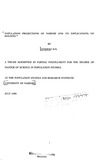| dc.description.abstract | One of the greatest unsatisfied needs in the field of applied demography is to translate
population projections into practical implications for administration and policy. The
usual age-sex projections which demographers prepare only half-way meet this need.
Complete projections call for translating these age-sex projections into labour force,
school enrolment, household, hospitals, and other facilities and services that population
growth will have an impact on. This study is an attempt to translate the age-sex
population projections into household. The households form a basis for estimating
housing needs in Nairobi.
The study attempts to project the population of Nairobi by the five divisions. The
method used here is the inter-censal growth rate technique whereby the inter-censal
growth rate is fitted into the exponential formula and the projections are made by single
~:?!~
calendar years up to the year 2000. This is done for the total population by age as well
as by age-sex. These projections are then translated into housing needs for Nairobi.
Whereas different areas and zones of Nairobi require different standards of housing,
this aspect is not considered in this study as the economic approach is not employed.
The needs are estimated quantitatively regardless of standards and tastes so that the
planners and policy makers can decide on the standards and determine the tastes for
the different socio-economic groups. The households sizes vary with different socioeconomic
groups. However, the average household size estimated by 1983 urban housing
survey is used in this study.
The average household size for Nairobi estimated by the urban housing survey as 3.45
is not significantly different from the average household size for Nairobi estimated by
the 1979 census about 4. The 3.45 was adopted by this study for the purpose of
working, since as the cost of living and bringing up children is rocketing sky high, there
is a hope that most families will prefer smaller families. However, the average household
size is not expected to reduce so fast, say to two children per family. It is likely to take
sometime. The continued increase in housing needs in Nairobi is further attested to by
the graphical presentation in Charts 1 - 6.
,. | en |

